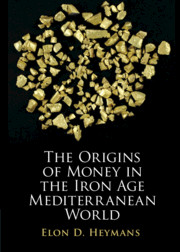Book contents
- The Origins of Money in the Iron Age Mediterranean World
- The Origins of Money in the Iron Age Mediterranean World
- Copyright page
- Contents
- Figures
- Maps
- Tables
- Preface
- Acknowledgements
- Author’s Note
- One Rethinking the Origins of Money
- Two Outline of an Approach to Money
- Three A Study of Iron Age Precious Metal Hoards
- Four Money in the Iron Age Southern Levant
- Five Money in the Iron Age Aegean
- Six Conclusion
- Appendix A Catalogue of Iron Age Precious Metal Hoards in Israel/Palestine
- Bibliography
- Index of Ancient Sources
- General Index
Three - A Study of Iron Age Precious Metal Hoards
Published online by Cambridge University Press: 17 September 2021
- The Origins of Money in the Iron Age Mediterranean World
- The Origins of Money in the Iron Age Mediterranean World
- Copyright page
- Contents
- Figures
- Maps
- Tables
- Preface
- Acknowledgements
- Author’s Note
- One Rethinking the Origins of Money
- Two Outline of an Approach to Money
- Three A Study of Iron Age Precious Metal Hoards
- Four Money in the Iron Age Southern Levant
- Five Money in the Iron Age Aegean
- Six Conclusion
- Appendix A Catalogue of Iron Age Precious Metal Hoards in Israel/Palestine
- Bibliography
- Index of Ancient Sources
- General Index
Summary
This chapter presents a detailed study of Iron Age precious metal hoards in the southern Levant (and one hoard in the Aegean), and uses the data from the hoards to reconstruct the early development of money use, and its historical and social context. The analyses focus on the archaeological and geographical context of the individual hoards, and the internal metrology and typology of the hoards. Most importantly, it is demonstrated that the hoards conform to chronologically coherent patterns of material characteristics. Starting at the end of the Late Bronze Age, silver jewellery and prestige items were increasingly appropriated for use in exchange as a form of money. Hoards from the latter phase of the Iron I reflect a high level of circulation, and the use of silver in small-scale transactions of a high level of precision, representing small change. After the end of the eighth century, the hoards dating to the Iron IIC cease to reflect the common use of silver money in exchange, indicating again a distinct change in the role of silver money in the economy.
- Type
- Chapter
- Information
- The Origins of Money in the Iron Age Mediterranean World , pp. 55 - 115Publisher: Cambridge University PressPrint publication year: 2021

